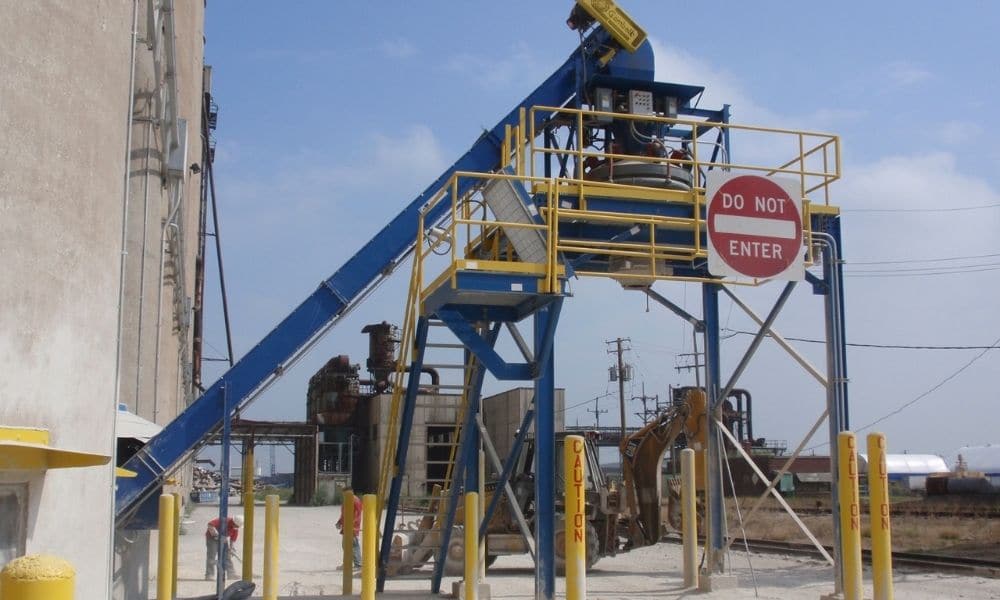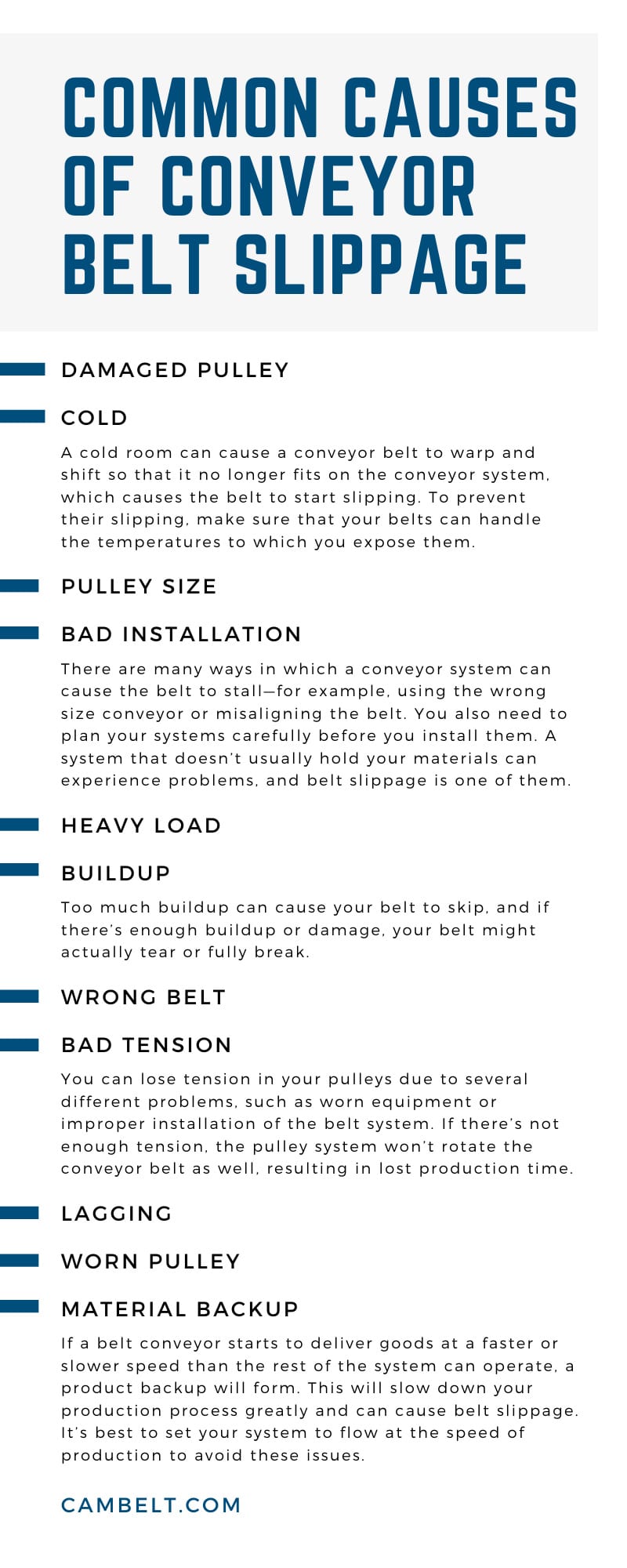
Belt conveyors are the most efficient equipment in many industries, as they speed up transportation and production times. However, they are a bit of an ongoing investment, as problems can arise over time, like a conveyor belt that keeps slipping. One of the major issues that many belt conveyors eventually develop is belt slippage. Belt slippage isn’t a horrible problem, as you can fix it quickly if you identify the cause. To help you do just that, read this list of the most common causes of conveyor belt slippage.
Cold
Not all conveyor belts designs can handle different environmental factors. One common factor that causes problems is cold temperature. A cold room can cause a conveyor belt to warp and shift so that it no longer fits on the conveyor system, which causes the belt to start slipping. To prevent their slipping, make sure that your belts can handle the temperatures to which you expose them.
Bad Installation
Improper conveyor system installation is another cause of belt slippage. There are many ways in which a conveyor system can cause the belt to stall—for example, using the wrong size conveyor or misaligning the belt. You also need to plan your systems carefully before you install them. A system that doesn’t usually hold your materials can experience problems, and belt slippage is one of them. Bad installation can easily be avoided by contacting professionals to install your system and avoid any future conveyer belt problems.
Buildup
Most materials leave small amounts of residue or damage as they travel on a conveyor system. This isn’t that important in the short term, but over time, this buildup can cause many problems. Too much buildup can cause your belt to skip, and if there’s enough buildup or damage, your belt might actually tear or fully break. The best way to avoid such damage is to perform regular maintenance and inspections to identify any damage and buildup. While a conveyor belt that keeps slipping is frustrating, it also causes downtime, resulting in your facility losing productivity.
Bad Tension
Other causes of conveyor belt failure can be blamed on bad tension. Conveyors work using a system of pulleys that move and rotate the conveyor belts. However, these systems only work if the conveyor belt sits properly on the pulleys, as the pulleys need proper tension to move the belt. You can lose tension in your pulleys due to several different problems, such as worn equipment or improper installation of the belt system. If there’s not enough tension, the pulley system won’t rotate the conveyor belt as well, resulting in lost production time.
Worn Pulley
Just like the belt itself, the pulleys on the belt conveyor system experience wear and tear over time. This can cause the belt to no longer perform to the best of its ability. A worn pulley has a hard time maintaining proper pressure and tension on a conveyor belt. The best way to avoid this problem is to run frequent inspections on your conveyor system and replace the pulleys if you find any issues.
Damaged Pulley
Much like a worn pulley, a damaged pulley can cause quite a few problems. Belt slippage frequently occurs when a pulley has been damaged, but there are other ways that a damaged pulley can negatively impact your material handling. To catch damage quickly, perform inspections on your pulleys at least once a month.
Pulley Size
The size of your pulley isn’t something you need to worry about often, but you should know that an improper pulley size can lead to belt slippage. You need to be sure that your pulleys are the same size throughout your entire belt conveyor; otherwise, you’ll have lots of belt slippages. Having two different size pulleys isn’t a common problem. However, replacing a broken pulley can create this problem if you accidentally install the wrong pulley or one that is older than the other.
Heavy Load
Conveyor belts carry heavy loads all the time, but they do have their limits. One common cause of conveyor belt slippage is exceeding the conveyor system’s weight limit when transporting materials and products. When a conveyor belt tries to move things heavier than its limit, the belt may slip or stop moving altogether, depending on the weight of the objects. Make sure you have a conveyor system that can keep up with the materials you need it to move without danger of overload.
Wrong Belt
There are two situations in which you can have the wrong type of belt: if you install a belt that is incapable of handling your materials and load, or if you install the wrong kind of belt after replacing the original one. To solve the first problem, make sure your belt can handle the weight of your material. You’ll also need to consider the kind of material your conveyor system will be transporting and that material’s special requirements. For example, a belt carrying liquids or sand will have different requirements than one transporting more standard, solid objects. You should also consider the damage the materials can cause to your belt. Hard metals or sharp edges can damage the belt during transport. If you’re replacing a bad belt, make sure you replace it with a belt that meets all these specifications while still being the correct size for your conveyor system.
Material Backup
Is your conveyor operating at the right speed? Another common cause for slipping belts is a material backup. When your conveyor system transports products or materials, it needs to follow the speed of production. If a belt conveyor starts to deliver goods at a faster or slower speed than the rest of the system can operate, a product backup will form. This will slow down your production process greatly and can cause belt slippage. It’s best to set your system to flow at the speed of production to avoid these issues.
Lagging
Lagging is very important to stop slippage in conveyor belts, as it’s what helps the belt grip the rollers. Proper lagging can help the belt utilize the rollers and pulleys to move without applying too much tension. You should be careful when installing lagging because having improper lagging is just as bad as having no lagging at all.
These are just a few of the common causes of conveyor belt slippage—you can see there are quite a few factors to balance. Properly maintaining your conveyor system is the first thing you can do to prevent belt slippage. You should also invest in a mobile belt conveyor manufacturer, as these professionals can help you install your belt conveyors and plan for your materials. You can also hire a professional to do repairs to ensure that your conveyors will have as few problems as possible to prevent your conveyor belt from slipping in the future.

